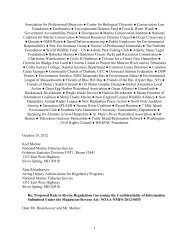About OMB Watch
Chapter III Technology Advisory Committee - OMB Watch
Chapter III Technology Advisory Committee - OMB Watch
- No tags were found...
Create successful ePaper yourself
Turn your PDF publications into a flip-book with our unique Google optimized e-Paper software.
database of names or about a recruitment effort, fearing that: (a) it was a power-play by<br />
national organizations to develop a centralized database of nonprofit organizations, bypassing<br />
state-based organizations; (b) recruitment would be competitive with membership<br />
organizations or existing online services; (c) the names might be used for inappropriate<br />
solicitations (such as fundraising); (d) they might lose control over the names, which,<br />
in turn, translates into power; and (e) maintenance of a centralized national database of<br />
names would be very difficult.<br />
The issues associated with the contact database and with outreach/recruitment are<br />
very sensitive ones, yet are central to improved communications within the sector. While<br />
technical solutions can be found to these issues, the real key is whether there is enough<br />
trust among key groups to build the cooperation, collaboration, and coordination that is<br />
necessary to make this initiative successful. We believe a “working group” needs to be<br />
established to discuss these issues and develop recommendations. Discussion of this<br />
working group is found under the “Implementation” section below.<br />
While <strong>OMB</strong> <strong>Watch</strong> did not receive enough input on the subject of how to create a<br />
coordinated registration structure to recommend a specific approach, we believe that<br />
these issues can be resolved. In today’s Internet world, the contact database can be<br />
constructed so that state-based and membership organizations or online services can<br />
still retain the database of names or be given control over the use of the names. They<br />
must, however, work cooperatively to develop standardized information collection and<br />
database formats (although they may individually want to collect additional information<br />
beyond the common standard). One approach would be to have each of these organizations<br />
maintain their respective databases on their own computers, but have them linked<br />
in a distributed manner. Alternatively, a common World Wide Web registration form could<br />
be made available through each organization or service which automatically stores the<br />
information in a centrally located computer, but is regionally (or state or locally) maintained<br />
and updated. In each example, the control over the contact database can be local,<br />
while the location of the computer may or may not be local.<br />
Once a registration structure is agreed upon, it will be necessary to recruit organizations<br />
to participate. This might be done through existing online services, such as HandsNet,<br />
and through national and state conferences. The recruitment can also be done through<br />
state nonprofit associations and other key state organizations, which, if agreements are<br />
reached, could help to strengthen the state organizations themselves. These groups<br />
could expand their nonprofit membership base, while simultaneously helping to build a<br />
bigger base of nonprofit organizations potentially ready to engage in policy matters.<br />
Even recruitment need not result in any organization “giving up” its database of contacts.<br />
As described above, one approach would be to emphasize self-registration, asking<br />
key organizations and services to “advertise” the availability of the communications mechanisms.<br />
It is likely, however, that new outreach efforts will need to be developed to reach<br />
nonprofit organizations not now affiliated with existing organizations (e.g., state associations,<br />
national organizations).<br />
Second, “coordination matrix” software needs to be developed that permits registrants<br />
to identify the type of information they want to receive. Registrants should be able<br />
to select: topics they are interested in; whom they want to receive information from (e.g.,<br />
names of organizations); types of documents they want (e.g., alerts, research findings);<br />
length of documents (e.g., nothing longer than 10 pages); the media for receiving the<br />
documents (e.g., fax, e-mail); and other items. Registrants should be able to change the<br />
filters easily to fit their needs so that they have control over what they receive. We have<br />
<strong>OMB</strong> <strong>Watch</strong> — May 1997<br />
• 13



